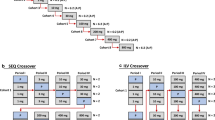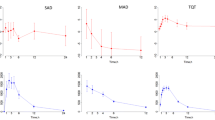Abstract
The International Council for Harmonisation revised the E14 guideline through the questions and answers process to allow concentration-QTc (C-QTc) modeling to be used as the primary analysis for assessing the QTc interval prolongation risk of new drugs. A well-designed and conducted QTc assessment based on C-QTc modeling in early phase 1 studies can be an alternative approach to a thorough QT study for some drugs to reliably exclude clinically relevant QTc effects. This white paper provides recommendations on how to plan and conduct a definitive QTc assessment of a drug using C-QTc modeling in early phase clinical pharmacology and thorough QT studies. Topics included are: important study design features in a phase 1 study; modeling objectives and approach; exploratory plots; the pre-specified linear mixed effects model; general principles for model development and evaluation; and expectations for modeling analysis plans and reports. The recommendations are based on current best modeling practices, scientific literature and personal experiences of the authors. These recommendations are expected to evolve as their implementation during drug development provides additional data and with advances in analytical methodology.




Similar content being viewed by others
Change history
12 January 2018
The original version of this article unfortunately contained an error in Equation 1 under the section “Pre-specified linear mixed effects model”. The correct equation has given below.
Abbreviations
- AIC:
-
Akaike information criteria
- C:
-
Concentration
- CI:
-
Confidence intervals
- Cmax :
-
Maximum concentration
- C-QTc:
-
Concentration-QTc
- ΔHR:
-
Baseline-corrected heart rate
- ΔQTc:
-
Baseline-corrected QTc interval
- ΔΔQTc:
-
ΔQTc interval corrected for placebo
- ECG:
-
Electrocardiogram
- Emax :
-
Maximum effect
- ER:
-
Extended release
- GOF:
-
Goodness-of-fit
- hERG:
-
Human ether-a-go-go-related gene
- HR:
-
Heart rate
- ICH:
-
International Council for Harmonization
- IR:
-
Immediate-release
- ms:
-
Milliseconds
- LME:
-
Linear mixed effects
- MAD:
-
Multiple-ascending dose
- MAP:
-
Modeling analysis plan
- MD:
-
Multiple dose
- PK:
-
Pharmacokinetic
- PD:
-
Pharmacodynamics
- QT:
-
QT interval on ECG
- QTc:
-
QT interval corrected for heart rate
- QTcF:
-
Fridericia corrected QT interval
- SAD:
-
Single-ascending dose
- SD:
-
Single dose
- TQT:
-
Thorough QT/QTc
References
ICH E14 Guideline (2015) The clinical evaluation of QT/QTc interval prolongation and proarrhythmic potential for non-antiarrhythmic drugs. Questions & answers (R3). http://www.ich.org/fileadmin/Public_Web_Site/ICH_Products/Guidelines/Efficacy/E14/E14_Q_As_R3__Step4.pdf
ICH E14 Guideline (2005) The Clinical evaluation of QT/QTc interval prolongation and proarrhythmic potential for non-antiarrhythmic drugs. http://www.ich.org/fileadmin/Public_Web_Site/ICH_Products/Guidelines/Efficacy/E14/E14_Guideline.pdf
Marshall SF et al (2016) Good practices in model-informed drug discovery and development: practice, application, and documentation. CPT Pharm Syst Pharmacol 5(3):93–122
Ferber G, Zhou M, Darpo B (2015) Detection of QTc effects in small studies—implications for replacing the thorough QT study. Ann Noninvasive Electrocardiol 20(4):368–377
Garnett CE et al (2012) Methodologies to characterize the QT/corrected QT interval in the presence of drug-induced heart rate changes or other autonomic effects. Am Heart J 163(6):912–930
Malik M, Hnatkova K, Batchvarov V (2004) Differences between study-specific and subject-specific heart rate corrections of the QT interval in investigations of drug induced QTc prolongation. Pacing Clin Electrophysiol 27(6 Pt 1):791–800
Zhang J, Machado SG (2008) Statistical issues including design and sample size calculation in thorough QT/QTc studies. J Biopharm Stat 18(3):451–467
Malik M et al (2008) Near-thorough QT study as part of a first-in-man study. J Clin Pharmacol 48(10):1146–1157
Darpo B et al (2015) Results from the IQ-CSRC prospective study support replacement of the thorough QT study by QT assessment in the early clinical phase. Clin Pharmacol Ther 97(4):326–335
Nelson CH et al (2015) A quantitative framework to evaluate proarrhythmic risk in a first-in-human study to support waiver of a thorough QT study. Clin Pharmacol Ther 98(6):630–638
Darpo B et al (2014) The IQ-CSRC prospective clinical Phase 1 study: “Can early QT assessment using exposure response analysis replace the thorough QT study?”. Ann Noninvasive Electrocardiol 19(1):70–81
Ferber G, Lorch U, Taubel J (2015) The power of phase i studies to detect clinical relevant QTc prolongation: a resampling simulation study. Biomed Res Int 2015:293564
Garnett C et al (2016) Operational characteristics of linear concentration-QT models for assessing QTc interval in the thorough QT and I clinical studies. Clin Pharmacol Ther 100(2):170–178
Zhang J (2008) Testing for positive control activity in a thorough QTc study. J Biopharm Stat 18(3):517–528
Ferber G et al (2017) Can bias evaluation provide protection against false-negative results in QT studies without a positive control using exposure-response analysis? J Clin Pharmacol 57(1):85–95
Taubel J, Ferber G (2015) The reproducibility of QTc changes after meal intake. J Electrocardiol 48(2):274–275
Taubel J, Fernandes S, Ferber G (2017) Stability of the effect of a standardized meal on QTc. Ann Noninvasive Electrocardiol. https://doi.org/10.1111/anec.12371
Zhang J, Dang Q, Malik M (2013) Baseline correction in parallel thorough QT studies. Drug Saf 36(6):441–453
Mehrotra DV et al (2017) Enabling robust assessment of QTc prolongation in early phase clinical trials. Pharm Stat 16(3):218–227
Bonate PL (2013) Effect of assay measurement error on parameter estimation in concentration-QTc interval modeling. Pharm Stat 12(3):156–164
Gastonguay MR (2004) A full model estimation approach for covariate effects: inference based on clinical importance and estimation precision. AAPS J 6(S1):W4354
Tornoe CW et al (2011) Creation of a knowledge management system for QT analyses. J Clin Pharmacol 51(7):1035–1042
FDA (1999) Guidance for industry: population pharmacokinetics. U.S.D.O.H.H. Services. http://www.fda.gov/downloads/Drugs/…/Guidances/UCM072137.pdf
FDA (2010) Drug safety communication: abnormal heart rhythms associated with use of Anzemet (dolasetron mesylate). 2010 [cited 11 July 2016]. http://www.fda.gov/Drugs/DrugSafety/ucm237081.htm
Holford NH et al (1981) The effect of quinidine and its metabolites on the electrocardiogram and systolic time intervals: concentration–effect relationships. Br J Clin Pharmacol 11(2):187–195
Glomb P, Ring A (2012) Delayed effects in the exposure-response analysis of clinical QTc trials. J Biopharm Stat 22(2):387–400
Wang JX, Li WQ (2014) Test hysteresis in pharmacokinetic/pharmacodynamic relationship with mixed-effect models: an instrumental model approach. J Biopharm Stat 24(2):326–343
EMA (2017) Guideline on reporting the results of population pharmacokinetic analyses. 2007 [cited 2016]. http://www.ema.europa.eu/docs/en_GB/document_library/Scientific_guideline/2009/09/WC500003067.pdf
Bonate PL (2013) The effects of active metabolites on parameter estimation in linear mixed effect models of concentration-QT analyses. J Pharmacokinet Pharmacodyn 40(1):101–115
Sinclair K et al (2016) Modelling PK/QT relationships from phase I dose-escalation trials for drug combinations and developing quantitative risk assessments of clinically relevant QT prolongations. Pharm Stat 15(3):264–276
Zhu H et al (2010) Considerations for clinical trial design and data analyses of thorough QT studies using drug–drug interaction. J Clin Pharmacol 50(10):1106–1111
Mehta R et al (2016) Concentration-QT analysis of the randomized, placebo- and moxifloxacin-controlled thorough QT study of umeclidinium monotherapy and umeclidinium/vilanterol combination in healthy subjects. J Pharmacokinet Pharmacodyn 43(2):153–164
Sarapa N, Britto MR (2008) Challenges of characterizing proarrhythmic risk due to QTc prolongation induced by nonadjuvant anticancer agents. Expert Opin Drug Saf 7(3):305–318
Isbister GK, Friberg LE, Duffull SB (2006) Application of pharmacokinetic-pharmacodynamic modelling in management of QT abnormalities after citalopram overdose. Intensive Care Med 32(7):1060–1065
Johannesen L et al (2014) Differentiating drug-induced multichannel block on the electrocardiogram: randomized study of dofetilide, quinidine, ranolazine, and verapamil. Clin Pharmacol Ther 96(5):549–558
Johannesen L et al (2016) Late sodium current block for drug-induced long QT syndrome: results from a prospective clinical trial. Clin Pharmacol Ther 99(2):214–223
Taubel J et al (2012) Shortening of the QT interval after food can be used to demonstrate assay sensitivity in thorough QT studies. J Clin Pharmacol 52(10):1558–1565
Taubel J et al (2013) Insulin at normal physiological levels does not prolong QT(c) interval in thorough QT studies performed in healthy volunteers. Br J Clin Pharmacol 75(2):392–403
Shah RR et al (2015) Establishing assay sensitivity in QT studies: experience with the use of moxifloxacin in an early phase clinical pharmacology study and comparison with its effect in a thorough QT study. Eur J Clin Pharmacol 71(12):1451–1459
Huh Y, Hutmacher MM (2015) Evaluating the use of linear mixed-effect models for inference of the concentration-QTc slope estimate as a surrogate for a biological QTc model. CPT Pharm Syst Pharmacol 4(1):e00014
Disclaimer
The views presented in this article are the personal opinions of the authors and do not reflect the official views of their respective organizations.
Author information
Authors and Affiliations
Corresponding author
Additional information
The original version of this article was revised: The error in Equation 1 has been corrected.
Electronic supplementary material
Below is the link to the electronic supplementary material.
Rights and permissions
About this article
Cite this article
Garnett, C., Bonate, P.L., Dang, Q. et al. Scientific white paper on concentration-QTc modeling. J Pharmacokinet Pharmacodyn 45, 383–397 (2018). https://doi.org/10.1007/s10928-017-9558-5
Received:
Accepted:
Published:
Issue Date:
DOI: https://doi.org/10.1007/s10928-017-9558-5




